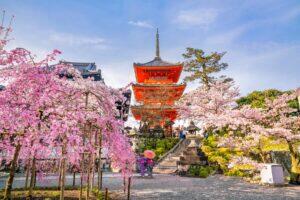Fodor's Expert Review To-ji Temple
Famous for its towering pagoda, the most prominent one visible when entering the city, the temple of To-ji was established by imperial edict in AD 796 and called the East Temple. Farther west was Sai-ji, the West Temple, but receiving no special patronage it was long ago destroyed. To-ji, on the other hand, was assigned to the priest Kukai (AD 774–835), also known as Kobo Daishi, a major figure in Japanese Buddhism whose accomplishments include founding the Shingon sect in the early 9th century and establishing the 88-temple pilgrimage on the island of Shikoku.
Fires and battles during the 16th century destroyed the temple buildings, but many were rebuilt, including in 1603 the Kon-do (Main Hall), which blends Chinese and Japanese elements. The one building that has managed to survive the ravages of war since it was built in 1491 is the Ko-do (Lecture Hall). Inside this hall are 15 original statues of Buddhist gods, forming a mandala, that are considered masterpieces of the... READ MORE
Famous for its towering pagoda, the most prominent one visible when entering the city, the temple of To-ji was established by imperial edict in AD 796 and called the East Temple. Farther west was Sai-ji, the West Temple, but receiving no special patronage it was long ago destroyed. To-ji, on the other hand, was assigned to the priest Kukai (AD 774–835), also known as Kobo Daishi, a major figure in Japanese Buddhism whose accomplishments include founding the Shingon sect in the early 9th century and establishing the 88-temple pilgrimage on the island of Shikoku.
Fires and battles during the 16th century destroyed the temple buildings, but many were rebuilt, including in 1603 the Kon-do (Main Hall), which blends Chinese and Japanese elements. The one building that has managed to survive the ravages of war since it was built in 1491 is the Ko-do (Lecture Hall). Inside this hall are 15 original statues of Buddhist gods, forming a mandala, that are considered masterpieces of the Heian era (AD 750–1150). There's a daily morning service at 6 am in the Daishi-do with devotional chanting.
On the 21st of each month, a market known locally as Kobo-san (after Kobo Daishi) is held. Used and old kimonos, fans, furniture, potted plants, oriental medicine, kitchen utensils, and many other items can be found at bargain prices. A little patience and a pencil and paper to write down your desired price will make the venture an enjoyable one. A smaller antiques market is held on the first Sunday of the month.
READ LESS







